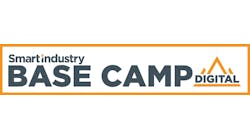In just a few days, Tom Walker presents “Secure Network Foundation Needed for Maintenance Analytics” at the fourth-annual Smart Industry Conference. Today the systems design specialist with Penn State University shares his thoughts on overseeing a smart campus. Take a look…
Smart Industry: How is a managing a university campus similar to running an industrial facility? How is it different?
Tom: Manufacturing and industrial facilities have the same plants (power, cooling, heating, steam, water, waste water) as a university. These plants can be for single building or a campus of multiple buildings. Both can have very restrictive or specific design requirements depending on the type of facility and its purpose. The main difference is time/execution; though controls are similar, facilities don't operate in the seconds or milliseconds. For our purposes, 15 minutes is near real-time.
Smart Industry: Describe your Office of the Physical Plant. Is this a common setup at large university?
Tom: The Office of Physical Plant (OPP) is made up of several departments that together provide facility services for the university. This includes Buildings & Grounds, Campus Planning & Design, Design & Construction, Energy & Engineering, Environmental Health & Safety, Facilities & Resource Planning, and Work Control. OPP manages and maintains the 22,000 acres of land and the 32 million square feet of buildings at University Park.
Most large universities have similar setups with a central-facilities group managing the land, buildings and utilities on campus. Some have large groups that do most things in-house, while others have small groups and much of the work is outsourced via contracts.
Smart Industry: What assets are we talking about? What’s the most unusual campus asset you monitor?
Tom: We currently monitor building-automation controls, electrical distribution, steam generation, water treatment, waste water, power generation (combustion turbine and solar), elevators, vibration, autoclaves, chimes, weather, lighting, security, fire systems, etc.
The oddest one to date is a road-conditions monitoring setup that includes a camera, infrared temperature sensor and mini weather station. It can tell the surface temperature of the road and give localized road conditions to the snow-removal crew.
Smart Industry: Describe the centralized orchestration engine. What does it enable you to do?
Tom: We have a couple of programs that work together to give us the ability to automate several tasks from a central system. One example is load shedding. We have a system called Enterprise Utility Management System (EUMS) made up of few different systems, currently, as we are migrating to a newer platform. This system allows us to push various commands to the buildings and have them perform certain actions. We can change the temperature setpoints to +/-3 from their normal settings, un-occupy all spaces or turn systems off completely.
Another example is Smart Scheduling. We now have a system that pulls schedule information from the campus central-scheduling software and then occupies or unoccupies the spaces based on that schedule. The first room type to have this deployed are classrooms (~400). We found most classrooms were scheduled from 7 am to 9 pm, seven days a week, but the space was only used once or twice in that timeframe. If the early projections are what they seem this could be a significant decrease in energy use once scaled out to the 1,800+ rooms available in the scheduling software.
Smart Industry: Describe some early wins. Was it tricky to get buy-in from the administration or was the whole team on board?
Tom: The team was on board from the beginning. Being able to monitor and remotely access the buildings from anywhere provides an operational advantage over standalone systems in buildings that tend to be left alone unless there is an issue. We moved to a virtualized infrastructure to host the virtual servers for all the different systems. These are backed up daily at different levels and even replicated to a disaster site that can have systems back on in hours. Technicians can access the web interface of the HMI and troubleshoot the problem before going out into the field, which enables them to have the right tools, parts and equipment before driving out to the site. Having all the servers and the data collected centrally then allows us to have alarms trigger a work order or send a value to the PM system and let it issue proactive work orders based off a trigger.
Smart Industry: Are students aware of this progressive management of their campus?
Tom: Some students and faculty are aware. We currently have projects involving the different departments on campus utilizing data collected by our systems.
With management changes this last year we are starting campaigns to involve more student engagement and show other departments the power we can bring to their projects/research. Previously we were not fully involved with the remote campus systems. We hosted a few, but that was the extent. Now we are beginning to provide services like project review, system design, support and monitoring. This provides a consistency within the university as a whole.


